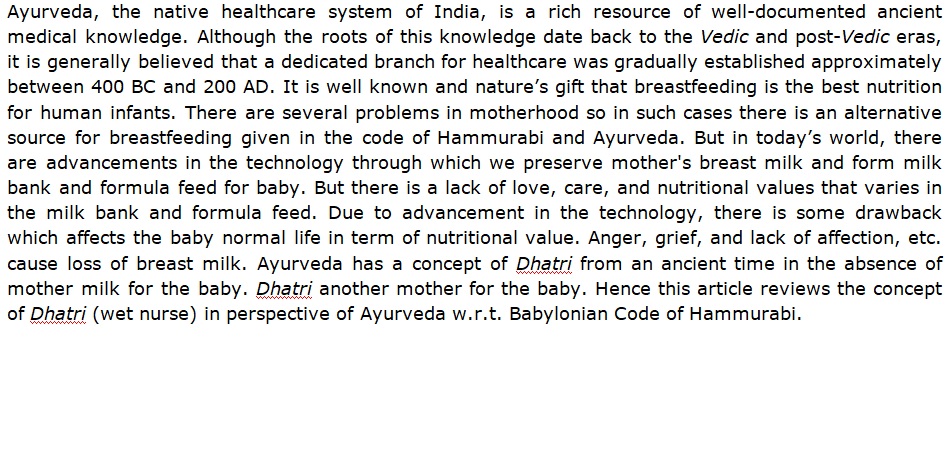Concept of Dhatri (wet nurse) in perspective of Ayurveda w.r.t. Babylonian Code of Hammurabi
DOI:
https://doi.org/10.21760/jaims.v6i01.1193Keywords:
Ayurveda, Breast-feeding, Code of Hammurabi, DhatriAbstract
Ayurveda, the native healthcare system of India, is a rich resource of well-documented ancient medical knowledge. Although the roots of this knowledge date back to the Vedic and post-Vedic eras, it is generally believed that a dedicated branch for healthcare was gradually established approximately between 400 BC and 200 AD. It is well known and nature’s gift that breastfeeding is the best nutrition for human infants. There are several problems in motherhood so in such cases there is an alternative source for breastfeeding given in the code of Hammurabi and Ayurveda. But in today’s world, there are advancements in the technology through which we preserve mother's breast milk and form milk bank and formula feed for baby. But there is a lack of love, care, and nutritional values that varies in the milk bank and formula feed. Due to advancement in the technology, there is some drawback which affects the baby normal life in term of nutritional value. Anger, grief, and lack of affection, etc. cause loss of breast milk. Ayurveda has a concept of Dhatri from an ancient time in the absence of mother milk for the baby. Dhatri another mother for the baby. Hence this article reviews the concept of Dhatri (wet nurse) in perspective of Ayurveda w.r.t. Babylonian Code of Hammurabi.
Downloads
References
Infant and Young Child Feeding Chapter, Indian Academy of Pediatrics, Bharadva K, Tiwari S, Mishra S, Mukhopadhyay k, Yadav B, et al, Human milk banking guidelines, Indian Pediatr, 2014 Jun;51(6);469-74.
Das BK, Mishra RN, Mishra OP, Bhargava V, Prakash A. Comparative outcome of low-birth-weight babies. Indian Pediatr. 1993;30:15-21.
Bharati P, Pal M, Bandyopadhyay M, Bhakta A, Chakraborty S, Bharati P. Prevalence and causes of low birth weight in India. Malayasian J Nutr. 2011;17: 301-13.
Agnivesha, Charaka, Dridhabala, Charak Samhita, Sutra Sthana, Annapanavidhiadhyaya, 27/224, edited by Sharma PV, Reprint ed. Chaukhambha Orientalia, Varanasi, 2011; 213.
Agnivesha, Charaka, Dridhabala, Charaka Samhita, Sharirasthana, Jatakarmavidhi Adhyaya, 8/46, edited by Sharma PV, Reprint ed. Chaukhamba Orientalia, Varanasi, 2011; 480.
Sushruta, Sushruta Samhita, ShariraSthana, Garbhinivyakarana Adhyaya, 10/24, translated by Prof. Srikantha Murthy KR. Vol. 1. Chaukhamba Orientalia, Varanasi, 2008.
Vagbhata, Ashatang Hridaya, with Sarvangsundara commentary, by Arundatta and the Ayurved Rasayana by Hemadri, Uttarasthana 1/16, edited by Pt. Shashtri Hari Sadashiv, Chaukhamba Surbharati Prakashan, Varanasi, Reprint ed 2017, 878.
Sushruta, Sushruta Samhita, ShariraSthana, Garbhinivyakarana Adhyaya, 10/25, translated by Prof. Srikantha Murthy KR. Vol. 1. Chaukhamba Orientalia, Varanasi, 2008.
Vriddhajivaka, Kashyapa, Kashyapa Samhita, Sutra sthana, Kshirottpattiadhyaya, 19 edited by Sharma Hemraj, Reprint Eighth edition, Chaukhamba Sanskrit Sansthan, Varanasi, 2008.
Sushruta, Sushruta Samhita, ShariraSthana, Garbhinivyakarana Adhyaya, 10/30, translated by Prof. Srikantha Murthy KR. Vol. 1. Chaukhamba Orientalia, Varanasi, 2008.
Agnivesha, Charaka, Dridhabala, Charak Samhita, Sutra sthana, Shadvirechanashatasritiya Adhyaya, 4/17, edited by Sharma PV, Reprint ed. Chaukhambha Orientalia, Varanasi, 2011.
Ashtang Sangraha, Uttartantra 1/53 stanyapanayana kala.
Code of hammurabi by history.com editors. original: nov 9, 2009. Updated on feb 21, 2020.
Agnivesha, Charaka, Dridhabala, Charaka Samhita, Sharir sthana, Jatisutriyaadhyaya, 8/52, edited by Sharma PV, Reprint ed Chaukhamba Orientalia, Varanasi, 2011; 483.
Sushruta, Sushruta Samhita, ShariraSthana, Siravedhavyadhasharira Adhyaya, 8/24, translated by Prof. Srikantha Murthy KR. Vol. 1. Chaukhamba Orientalia, Varanasi, 2008.
Vagbhata, Ashatang Hridaya, with Sarvangsundara commentary, by Arundatta and the AyurvedRasayana by Hemadri, Balopacharaniyaadhyaya Uttarasthana 1/15, edited by Pt. Shashtri Hari Sadashiv, Chaukhamba Surbharati Prakashan, Varanasi, Reprint ed 2017, 878.
Agnivesha, Charaka, Dridhabala, Charaka Samhita, Sharir sthana, Jatisutriyaadhyaya, 8/52, edited by Sharma PV, Reprint ed, Chaukhamba Orientalia, Varanasi, 2011; 483.
Sushruta, Sushruta Samhita, ShariraSthana, Garbhinivyakarana Adhyaya, 10/25, translated by Prof. Srikantha Murthy KR. Vol. 1. Chaukhamba Orientalia, Varanasi, 2008; 105.
Sushruta, Sushruta Samhita, Sutra Sthana, Karnavyadhabandhanavidhi Adhyaya, 16/3, translated by Prof. Srikantha Murthy KR. Vol. 1. Chaukhamba Orientalia, Varanasi, 2008; 84.
Agnivesha, Charaka, Dridhabala, Charaka Samhita, Sutrasthana, Ashtaudariyaadhyaya, 19/3, edited by Sharma PV, Reprint ed, Chaukhamba Orientalia, Varanasi, 2011; 132.
Agnivesha, Charaka, Dridhabala, Charaka Samhita, Sharirsthana, Jatisutriyaadhyaya, 8/58, edited by Sharma PV, Reprint ed, Chaukhamba Orientalia, Varanasi, 2011; 485.
Vriddhajivaka, Kashyapa, Kashyapa Samhita, Sutra sthana, Kshirottpattiadhyaya, 19/ edited by Sharma Hemraj, Reprint Eighth edition, Chaukhamba Sanskrit Sansthan, Varanasi, 2008.
Vagbhata, Ashatang Hridaya, with Sarvangsundara commentary, by Arundatta and the Ayurved Rasayana by Hemadri, Balopacharaniyaadhyaya Uttarasthana 1/20, edited by Pt. Shashtri Hari Sadashiv, Chaukhamba Surbharati Prakashan, Varanasi, Reprint ed 2017, 878.
Sushruta, Sushruta Samhita, Sharira Sthana, Garbhinivyakarana Adhyaya, 10/32, translated by Prof. Srikantha Murthy KR. Vol. 1. Chaukhamba Orientalia, Varanasi, 2008; 106.















